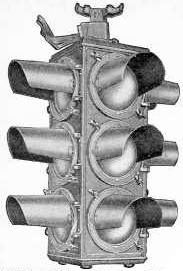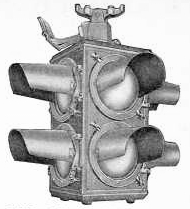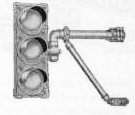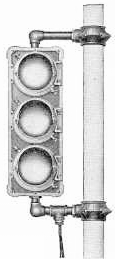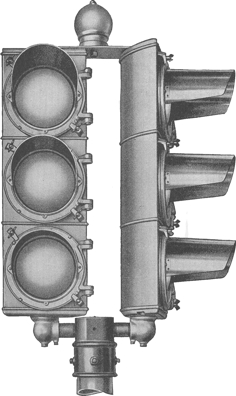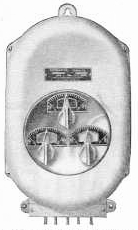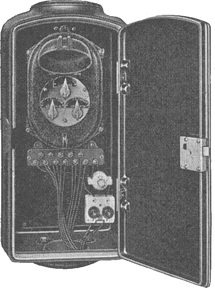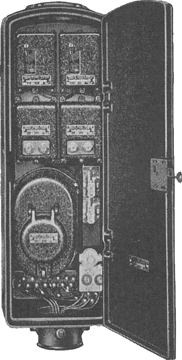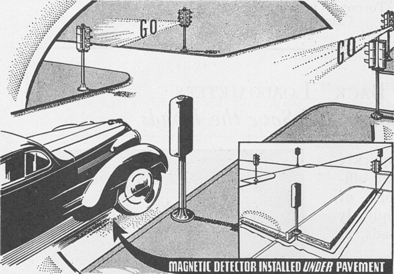Tokheim
Contents
- 1 Corporate History and Overview
- 2 Traffic Signals
- 2.1 Four Ways
- 2.2 Adjustables
- 2.2.1 Cut 1310 - One-Way, Post-Type, Traffic Control Signal
- 2.2.2 Cut 1400 - Horizontal Adjustable Post Bracket, Traffic Control Signal
- 2.2.3 Cut 1406 - One-Way, Vertical-Bracket Type, Traffic Control Signal
- 2.2.4 Cut 1410 - Vertical Adjustable Post Bracket, Traffic Control Signal
- 2.2.5 Sectional Signals
- 3 Pedestrian Signals
- 4 Informational Signals and Signs
- 5 Lenses
- 6 Controllers
- 7 Hardware
- 8 Miscellaneous Images
- 9 References
Corporate History and Overview
Following the February 1898 design of a gas pump by John J. Tokheim the Tokheim Manufacturing Company was incorporated in Cedar Rapids, Iowa in 1901. In 1918 employees of the Wayne company set out on their own, purchasing Tokheim and reincorporating it as the Tokheim Oil Tank and Pump Company, moving to Fort Wayne, Indiana in the old Wayne Spoke and Bending Company factory. In April 1926 they acquired the Signaphore company, also located in Fort Wayne, and formed the Tokheim Traffic Signal Division - although such branding has not been seen on their products, instead retaining the TOT&PCo. nomenclature. This acquisition brought along J. N. Paul of Automatic Signal Co. and Ruben E. Bechtold, from Signaphore. They would greatly develop and expand the Signaphore line into the modern traffic signal as well as introduce new controllers. By 1937 their interest in the product line waned and on January 8th, 1938 the transition of their signal interests both in design and manufacturing to Automatic Signal of East Norwalk, Connecticut, took place, along with pioneering traffic engineer Reuben E. Bechtold. [1]
Traffic Signals
When the Signaphore line was acquired they were producing novel 4-way traffic signal standards that appeared much like a round bodied gas pump with a traffic light on top. Like many manufacturers of the day they produced signals out of both aluminum and copper, later switching to all aluminum. Quite popular locally, they attracted the attention of Detroit, who requested pole-mount versions of the signal. Adjustable traffic signals would follow, and their market spread throughout the midwest including such cities as Cleveland, Chicago, and Detroit. It has been said they entered the international market too, however little is know of that.[1]
All Tokheim signals were designed with several characteristics:
All bodies are of cast aluminum Felt gaskets are used on the lense and door Doors are portholes held in place with two L-clamps and wingnuts All visors were cutaways with 8" length Reflectors are thick glass with an electrolytic copper plating Reflectors are held in a pan and mounted to the signal body Sockets are a porcelain Leviton wing style Wiring is done with rubber wire Lamps are 50-Watt household or 60-Watt traffic bulbs
Tokheim signals also had several options available (Mainly four-way exclusives):
Blank covers on one to three sides 15°, 30°, or 45° angled doors Traffic Bell
Four Ways
Cut 1200 - Four-Way Aerial Traffic Control Signal
Figure: Tokheim 1200 Signal. [Image by LC]
Cut 1260 - Four-Way, Two Color, Aerial Traffic Control Signal
No Yellow/Caution Lens
Figure: Tokheim 1260 Signal. [Image by LC]
Cut 1300 - Four-Way, Post-Type, Traffic Control Signal
Figure: Tokheim 1300 Signal. [Image by LC]
Sectional Signals
At some time, 4-way sectional heads were also made.
Adjustables
Cut 1310 - One-Way, Post-Type, Traffic Control Signal
Also available in two to five way clusters. Solid Body
Figure: Tokheim 1310 Signal. [Image by LC]
Cut 1400 - Horizontal Adjustable Post Bracket, Traffic Control Signal
Figure: Tokheim 1400 Signal. [Image by LC]
Cut 1406 - One-Way, Vertical-Bracket Type, Traffic Control Signal
Also available in two to four way clusters. Solid Body
Figure: Tokheim 1406 Signal. [Image by LC]
Cut 1410 - Vertical Adjustable Post Bracket, Traffic Control Signal
Figure: Tokheim 1410 Signal. [Image by LC]
Sectional Signals
This is a sectional signal head made by Tokheim.
Figure: Tokheim sectional head. [Image by LC]
Pedestrian Signals
Tokheim did not manufacture any pedestrian signals.
Informational Signals and Signs
describe models, variations [delete] includes "box signs," "case signs," and Ped Heads with special [non-ped] lenses.
Lenses
Lenses are 8 3/8" dia. with a 90° diffusing pattern. Command lenses are optional, with embossed letters two inches high, and a baked enamel finish.
Controllers
Controllers were individually settable for the Red, Yellow, and Green phases. Stop and Go could be set for anywhere from 15 sec. to 3 minutes. The clearance, yellow, could be set from two seconds to seven[?] seconds.
Cut 2000 - Chronoplan
Not a controller in itself, but the Tokheim guide on installation and setup of a traffic controller system utilizing a Chronolizer and several 1500 Timer modules. Improvements of up to 94% over the synchronized system and 43% over the staggered controller systems were guaranteed for a car doing the speed limit.
Chronolizer - Central Controller
This was a device attached to a series of 1500 timers to control a full roadway of signals in interoperation and coordination.
Cut 1500 - Traffic Signal Timer
Intoduced in 1925, the model 1500 was a local timer for controlling traffic signals.
Figure: Tokheim 1500 Signal Timer. [Image by LC]
Cut 1820 - Automatic Traffic Signal Control
The model 1820 was essentially a 1500 timer and associated circuitry in a cabinet to allow isolated operation of a single signal or intersection.
Figure: Tokheim 1820 Signal Controller. [Image by LC]
Magnetic Detector
Part of the later signal line upgrades included early magnetic detectors for vehicle-actuation. Following is an example of the controller with magnetic detection modules and a marketing image of an intersection configured as such.
Figure: Tokheim magnetic detectors. [Image by LC]
Hardware
this would include any kind of mounting hardware including brackets, slipfitters, hangers, bases, etc. [delete]
Miscellaneous Images
a couple of quality pics of a restored unit [delete]
References
[1] Back to the Future Tokheim, Bob Lee, 1993, ISBN 0-9638220-0-4
